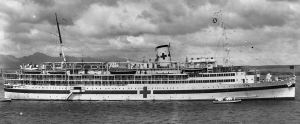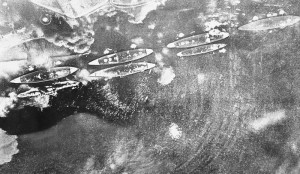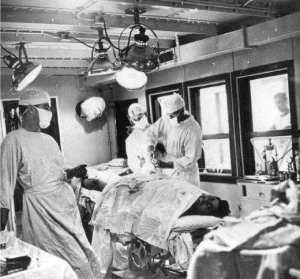First-Hand Account – corpsman
James F. Anderson
Hospital corpsman, USS Solace
James Anderson of Fort Worth, Texas was aboard the USS Solace looking out across the bay on 7 December as he awaited a liberty boat to take him to shore as 5 planes flew overhead. He spotted the red balls on the wings, “My God, those are Japanese. Let’s get this damn hatch shut!, he said. “Normally it took an electric winch to pull it shut. How 3 of us did it I’ll never know.”
“I remember very clearly what looked like a dive-bomber coming in over the Arizona and dropping a bomb. It rose out of the water and settled. I could see flames, fire and smoke…and I saw 2 men flying in the air…and screaming as they went. Then we went into the ward and checked everything and made ready for patients to arrive. Four of us set to with plaster-of-Paris.
“At this point, the Japanese planes were coming in alongside us… We could look straight into the cockpits and see the pilots as they went by us. Almost immediately we started getting casualties…only one of the men could tell us his name. He did not have a stitch of clothing on. The only thing left was a web belt with his chief’s buckle, his Chief-master-at-arms badge and the letters ‘USS Nevada.’ He survived…
“We were using tannic acid for the burns… All we could do for these poor fellows was to give them morphine and pour the tannic acid over them. We were making it from tea, boiling it up as strong as we could get it and bringing it straight to the ward from the galley.
“I think we must have gone through 48 hours without any sleep – all spent tending to our patients. There was so much adrenalin pumped into the body, a person couldn’t sleep… I got to the point I was staggering around… Nobody ever thought of asking for relief.”
James Anderson made his career as an enlisted man and continued his service until his retirement in 1960 when he returned to Texas.
This story was taken and condensed from, “The Pacific War Remembered” edited by John T. Mason Jr. and published by the Naval Institute Press, Annapolis, MD. Photos are courtesy of the USS Solace website.
TO SEE WHAT THESE MEN ACTUALLY WITNESSED – Fellow blogger, Koji was kind enough to send a link for us to do just that – watch the short video from – the Naval History $ Heritage
Click on images to enlarge.
################################################################################################
Humor –
################################################################################################
Farewell Salutes –
Walter Bailey – Jupiter, FL; US Army, WWII & Korea, Major (Ret. 25 years)
Irene Brainerd – Prairie Village, MO; US Army WACS, WWII, Quartermaster Corps
Harvey A. Chesley, Sr. – Clinton, ME; USMC, Vietnam
Gordon Conquergood – Toronto, CAN; RC Army, WWII
Richard Haas – Freeport, IL; US Army, Korea
Kenneth Irving Sr. – Clinton, ME; USMC, Korea
Michael Martin – Palm Bch Gardens, FL; US Army, WWII
Theodore Perry – Petaluma, CA; US Army, Rangers, Sgt.
Mark Priestly – Masterton, NZ; RNZ Navy # E746216
Fred Schrager – Brooklyn & Miami; US Army, WWII, POW, Silver Star, Bronze Star, Purple Heart
Charles (Bud) Willis – Bastrop, LA; US Army, Vietnam
################################################################################################
Eroni Kumana – Obituary
One of the Solomon Islands scouts who assisted in the rescue of the PT-109 crew passed away exactly 71 years after JFK’s boat was rammed while in the Pacific. Mr. Kumana was 96 years old. Kumana and fellow scout Biuku Gasa had discovered the Naval crew on Naru and Olasana islands.
A more complete story of this event will be posted when this series reaches August 1943.
###############################################################################################
Posted on August 28, 2014, in First-hand Accounts, WWII and tagged family history, Hawaii, History, Medic, Military, Navy, Pacific, Pearl Harbor, veterans, WWII. Bookmark the permalink. 58 Comments.















A Medics accounts of first hand action can never be amplified.
Only a Medic knows his emotions in his part of a war.
A Medics name is always called in war,
He is the intermediary between living and God.
Emu
LikeLike
I have always felt sorry for the medic. His name may be called and there is nothing he can do – the sorrow of watching so many die in your care must be unbearable. In war, the job of medic and chaplain amaze me.
LikeLiked by 1 person
Another really interesting post. Nothing is as fascinating as first hand accounts of great events.
LikeLike
They truly bring the story back to life, don’t they! Thank you for reading, John.
LikeLike
No matter how many textbooks I read during schooling, the books (and as you know, they had a couple of chapters on WWII unlike the two paragraphs today), I don’t ever recall reading about Corpsmen or medics. It’s a shame as they were shot or killed just like the wounded they were caring for.
I love Bill Mauldin and “Willie and Joe”. His cartoons were in the papers back then. My heart sank when he passed away. He did participate in combat and his cartoons were accurate: grim and real.
LikeLike
Dennis @ A Trivial Mind, said he used to own the book by Mauldin and I was jealous – I got on line Friday and ordered it – I’ll soon have a collection of those cartoons – can’t wait – but still don’t know why I didn’t order it before…duh!
There seems to be a lot our schools didn’t teach us, that’s why I’m always saying to the readers that I learn with all this research right along with them. And of course much of the data is still (to this date) being de-classified out of the Archives. With all the cutbacks – the work slows down. The medics and chaplains deserve far more coverage than they get! Thanks for for being here!!
LikeLike
Tannic acid, and actually any form of tannin saved many lives. This remedy was well known centuries ago. Tannin has antibacterial effect and prevents loss of blood plasma on the cellular level.
Grateful for the war surgeons and nurses. They have seen hell.
LikeLike
And thank you for the added data on the tannic acid, Mia.
LikeLiked by 1 person
Wonderful text complete with comic relief! Thank you!
LikeLike
You’re very welcome, thank you for reading and helping the world to remember!
LikeLike
I find personal stories really bring events that we all know about alive. They add a human touch to what Hollywood has ‘over romanticised’ and made entertainment. Tea is certainly a new one on me but the thread pretty much explains it all. I must admit I thought it was hot tea which I found a little odd to say the least. A fabulous post though thanks for sharing it and may they all rest in peace.
LikeLike
Thanks for your comments and for taking the time to read here today. From someone with such a well-informed blog, I consider that quite the compliment.
LikeLike
You’re too kind. The pacific is an area of the Second World War that is often left out maybe because of the gross atrocities that went on, the environment or simply because it’s not ‘popular’ with historians. I don’t know but it is good to see such good first hand informative writing keeping the lives of those involved alive. It’s taught me a lot personally.
LikeLike
We’re of one thought!!
LikeLike
Another was saline for burns. Some observant Brit medic spotted that pilots who came down over/into the Channel had fewer/lesser/less severe burns than those over land …
LikeLiked by 1 person
I’ve heard different theories on sea water as a treatment; after checking into it – I’m still confused some say yes others no. Since I don’t have an MD on the end of my name – I can only guess. Thanks for adding in and sharing, Argus.
LikeLike
Putting cold brewed black iced tea bags on a sun burn is still a common practice. The tannic acid in the tea draws the heat from the burn and helps to restore the acid balance to he skin. If they could have included fresh mint, in the brew, it would have added to the soothing effect of the mixture. I’ve used cotton towels soaked in black tea and it does help.
LikeLike
That’s very good to know; some of those old home-grown remedies really do a job!! Thanks.
LikeLike
Another great first-hand account! Thanks for another great post.
I enjoyed the Mauldin cartoons. I used to have his book that was full of them.
LikeLike
Oh, what I wouldn’t give to have that book!! I might have to check out some used book stores, I get such a kick out them; they remind me of my father’s sense of humor. Thanks for dropping in, Dennis.
LikeLike
Another amazing story. Tannic acid–we are creative.
LikeLike
I suppose, with that many burn victims, they HAD to be creative. Thanks for reading, Jacqui.
LikeLike
I read about Eroni Kumana a few weeks ago and then went and read more about him. He even named one of his children ‘John Fitgerald Kennedy Kumani.’
LikeLike
Yes, very true. Quite a story for him and his friend, two native teenage boys acting as scouts in a world war. I plan on putting a larger story for him and Gasa in August 1943, when the series gets to their famous discovery.
LikeLike
I’ve been reading your first hand accounts this morning. They’re really informative and interesting. It’s one thing to read about the famous (mostly) men or of statistics and large numbers, but you bring it home by identifying singular people or specific instances with what are essentially Everyman.
LikeLike
Thank you, Steven for taking the time to read the stories of these people that helped to shape the world back then. Statistics just don’t tell the whole story – I always feel I need to add an eye-witness to the events. (It also helps to confirm the statistics – don’t you think?
LikeLiked by 1 person
It gives weight to them.
Thousands of pyramids were build over a 1000 years by millions of Everyman, yet we only recall a few of (what we consider the) most important pyramids and the Kings who built them. All those people are forgotten in phrases like, “they were build”, or “the king built them”.
The near history you talk about can not help but do the same thing. Where as no records exist of the everyman until recently, these stories you tell preserve the integrity of history so it’s possible to look back not at Presidents and Generals but the individual people who make history progress.
LikeLike
What an overwhelming compliment and explanation of what I’m trying to do. I see you have noticed – that even though I quote the generals, admirals and politicians in the posts, I do try to avoid the first-accounts from them. I feel they already have their diaries and biographies published and museums build in their names. Thank you, Steven.
LikeLiked by 1 person
😉
LikeLike
(whoops, hit reply too soon)
…and so I thank you.
LikeLike
First hand accounts like this are matchless for putting the reader in the thick of the action.
LikeLike
I’m very glad you like them, because that was my intent. Just a couple more and we’ll go on with the war some more.
LikeLike
As a Navy/Marine Corps CORPSMAN of the 1960’s I can appreciate what my Brothers of the 40’s went through!
LikeLike
GREAT to have you comment here!! Would love to hear your story (stories). The comments are always open….
Very happy to hear you enjoyed the post, Jim.
LikeLike
Wow, just wow.
LikeLike
Thanks, Amberly – it doesn’t get any better than that!
LikeLiked by 1 person
I love the first hand accounts. Thanks for the link to the film footage too.
LikeLike
The first-hand accounts always seem to go over well. I think it’s the feeling of a personal touch to the story. Seeing the quotes and getting it from them – not historians. The film footage is from Koji, who can be found at the link below or you can wait for a reblog of one his posts this Saturday. I wanted to reblog his first posts, to show how both sides of the Pacific were affected, but he says it’s too long – so____
http://p47koji.wordpress.com/
LikeLike
Another great point of view. Despite the tannic acid treatment I bet that ship was a Solace to many. You may be interested in this anniversary. http://www.nzhistory.net.nz/media/photo/eleanor-roosevelt-visits-new-zealand It’s 71 years since Eleanor Roosevelt’s war time visit to the Pacific.
LikeLike
You might as well say the the US already had their first woman president with Elinor. When FDR was really sick, it was she who went into the meetings behind closed doors. (But, as with most politicians, there was another side to her).
LikeLike
That’s an interesting point of view, too. It’s intriguing what an important role the First Lady has. Our politicians’ partners are so unseen.
LikeLike
Maybe hidden, but just as in our Bill Clinton days – the partner was definitely heard!
LikeLike
Thank you for the link and for reading!!
LikeLike
It is probably English, we believe that a good cup of tea can cure anything 😀
LikeLike
Hahahaha, good one! I wouldn’t be surprised!
LikeLike
Really enjoying these first hand accounts! The wounds these medical units must have seen can’t bear thinking about. Great pithy cartoons.
LikeLike
I’m sure you can imagine just how much stress Bill Mauldin gave the troops during the war. Thank you for coming by !!
LikeLike
The people who fought in the world wars were of amazing character. I love reading these stories. Thank you for this post. Yes, why did they use tannic acid for the burns? Never heard of it.
LikeLike
That’s one I’ll have to look up ( I should have thought about that before hand). Thanks for reading Rosh.
LikeLiked by 1 person
The best I can understand it, the tannic acid helped to seal the wound. Nowadays it is rarely used and is controversial as to its effectiveness.
LikeLiked by 1 person
I learned something new. Thanks for the information!;-)
LikeLike
That’s always good to hear! Like my father Smitty used to say – “The day I stop learning, do me a favor and please close the lid.”
LikeLiked by 1 person
Love the respect for the fallen heroes at the end… That Pearl Harbor attack must have been so horrific to experience first hand, from an enemy who have not declared war yet…
LikeLike
I thank you for the compliment on the Farewell Salutes – but you have to admit – it was THEY who did all the work. I can not imagine what these people went through.
LikeLike
Tannic acid for burns ? Oh man.
LikeLike
I had heard of that years ago, and I still don’t understand it.
LikeLiked by 1 person
Thank you.
LikeLike
Pingback: VIDEO Corpsman First Hand Account – NarrowPathMinistries